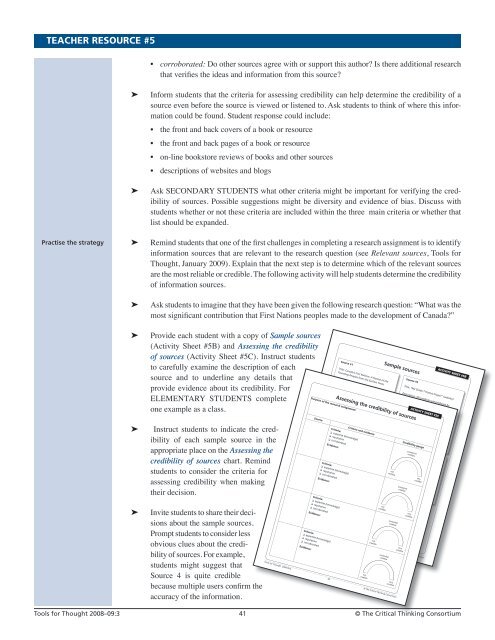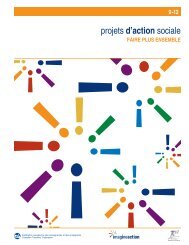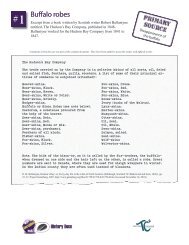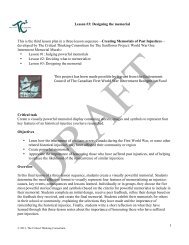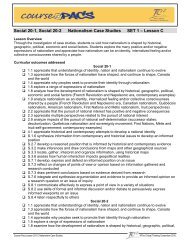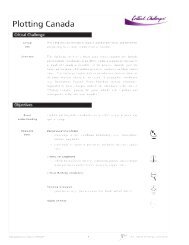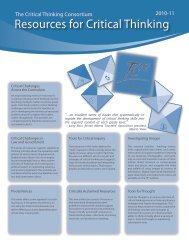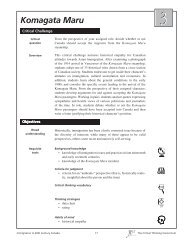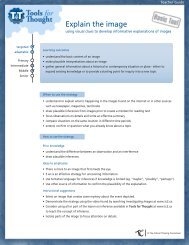Inquiry-mindedness - The Critical Thinking Consortium
Inquiry-mindedness - The Critical Thinking Consortium
Inquiry-mindedness - The Critical Thinking Consortium
Create successful ePaper yourself
Turn your PDF publications into a flip-book with our unique Google optimized e-Paper software.
TEACHER RESOURCE #5• corroborated: Do other sources agree with or support this author? Is there additional researchthat verifies the ideas and information from this source?Practise the strategy➤➤➤➤➤➤➤➤➤➤Inform students that the criteria for assessing credibility can help determine the credibility of asource even before the source is viewed or listened to. Ask students to think of where this informationcould be found. Student response could include:• the front and back covers of a book or resource• the front and back pages of a book or resource• on-line bookstore reviews of books and other sources• descriptions of websites and blogsAsk SECONDARY STUDENTS what other criteria might be important for verifying the credibilityof sources. Possible suggestions might be diversity and evidence of bias. Discuss withstudents whether or not these criteria are included within the three main criteria or whether thatlist should be expanded.Remind students that one of the first challenges in completing a research assignment is to identifyinformation sources that are relevant to the research question (see Relevant sources, Tools forThought, January 2009). Explain that the next step is to determine which of the relevant sourcesare the most reliable or credible. <strong>The</strong> following activity will help students determine the credibilityof information sources.Ask students to imagine that they have been given the following research question: “What was themost significant contribution that First Nations peoples made to the development of Canada?”Provide each student with a copy of Sample sources(Activity Sheet #5B) and Assessing the credibilityof sources (Activity Sheet #5C). Instruct studentsto carefully examine the description of eachsource and to underline any details thatprovide evidence about its credibility. ForELEMENTARY STUDENTS completeone example as a class.Source #1Title: Canada’s First Nations: A History of theFounding Peoples from the Earliest TimesDescription: Dr. Dickason is a retired professor,University of Alberta, and professor of history,University of Ottawa. She is the author ofseveral books, including <strong>The</strong> Laws of Nationsand the New World. Dr. Dickason was named amember of the Order of Canada, received theAboriginal Life Achievement Award, and hasPurpose of the won research the Canadian assignment: Historical Association’s bookprize. Throughout her distinguished career, sheSample sourcesSource #2Assessing the credibility of sourcesTitle: “My Grade 7 History Project” (website)Description: This website was produced bya student from Alberta for a grade 7 socialstudies project. His website includes a timelineof First Nations history and research he did forthe project. He has not included footnotes or abibliography.ACTIVITY SHEET #5CACTIVITY SHEET #5BSource Criteria and evidence Credibility gauge➤➤Instruct students to indicate the credibilityof each sample source in theappropriate place on the Assessing thecredibility of sources chart. Remindstudents to consider the criteria forassessing credibility when makingtheir decision.has remained proud of her Métis heritage. Thisbook was published in 2002 in Canada by OxfordUniversity Press.Criteria:Source #3❏ expertise (knowledge)❏ reputationTitle: A History of Canadian First Nations❏ corroboratedDescription: Evidence: C: Mr. McRoberts is an Americanbusiness owner and amateur history buff.Although this is his first book, it includesextensive endnotes and a list of sources thatsupport his writing. This book was self-publishedin 1970.Criteria:❏ expertise (knowledge)❏ reputation❏ corroboratedEvidence:Criteria:Source #4somewhatcredibleTitle: “First Nations” (Wikipedia entry)Description: This on-line encyclopedia entryhas been collaboratively created by hundredsof anonymous users with unknown expertise.Consensus is valued over credentials innotcredibleWikipedia. Every article can be edited butonly registered users can create a new article.verycredible<strong>The</strong> entry includes extensive endnotes and abibliography listing many supporting resources.somewhatcredible➤➤Invite students to share their decisionsabout the sample sources.Prompt students to consider lessobvious clues about the credibilityof sources. For example,students might suggest thatSource 4 is quite crediblebecause multiple users confirm theaccuracy of the information.❏ expertise (knowledge)❏ reputation❏ corroboratedEvidence:Tools for Thought 2008-09:3 44 © <strong>The</strong> <strong>Critical</strong> <strong>Thinking</strong> <strong>Consortium</strong>Criteria:❏ expertise (knowledge)❏ reputation❏ corroboratedEvidence:notcrediblenotcrediblesomewhatcrediblesomewhatcredibleTools for Thought 2008-09:3 45 © <strong>The</strong> <strong>Critical</strong> <strong>Thinking</strong> <strong>Consortium</strong>notcredibleverycredibleverycredibleverycredibleTools for Thought 2008–09:3 41 © <strong>The</strong> <strong>Critical</strong> <strong>Thinking</strong> <strong>Consortium</strong>


